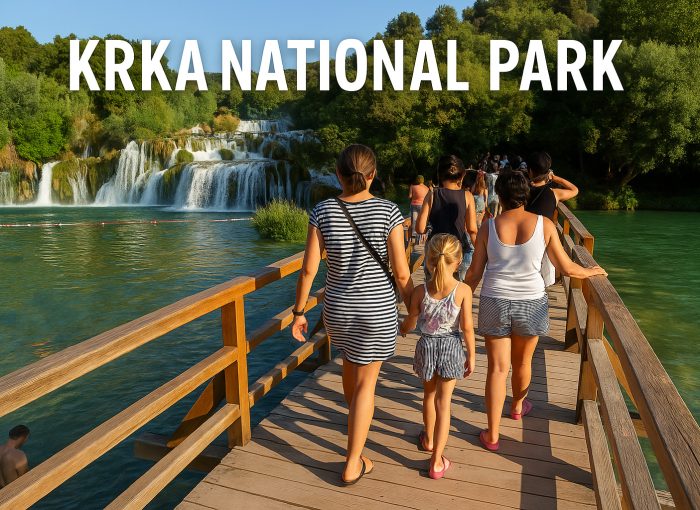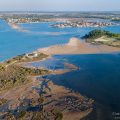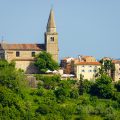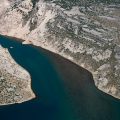Krka National Park is home to Croatia’s most beautiful waterfalls. Discover how to visit, what to see, and top tips for an unforgettable trip.
Krka National Park is one of Croatia’s most spectacular natural treasures, famous for its cascading waterfalls, emerald pools, and scenic walking trails. Located just a short drive from the Adriatic coast, this lush river park invites you to swim beneath waterfalls, wander wooden boardwalks through untouched nature, and explore centuries-old monasteries and ruins tucked deep in the greenery. Whether you’re in for a quick day trip or a slow nature escape, Krka offers a refreshing adventure for every type of traveler.
Table of Contents
Read more about the values of Krka National Park
Read the Guide for Croatian national and nature parks
Geography and landmarks of Krka National Park
The Krka River is the heart of Krka National Park, carving its way through a striking karst landscape and creating a series of breathtaking natural wonders along its 73-kilometer course. The river’s catchment spans over 2,000 square kilometers, making the national park a vast and varied region full of scenic viewpoints, cultural landmarks, and hidden corners to explore.
Krka springs from the base of the Krčić Waterfall, just outside the town of Knin. From there, it winds gently through meadows dotted with alder and willow trees before disappearing into the shadowy embrace of a dramatic canyon. For much of its journey, the river cuts through a harsh and arid terrain of bare limestone and thorny shrubs, but in the height of summer, this ribbon of water becomes a true oasis.
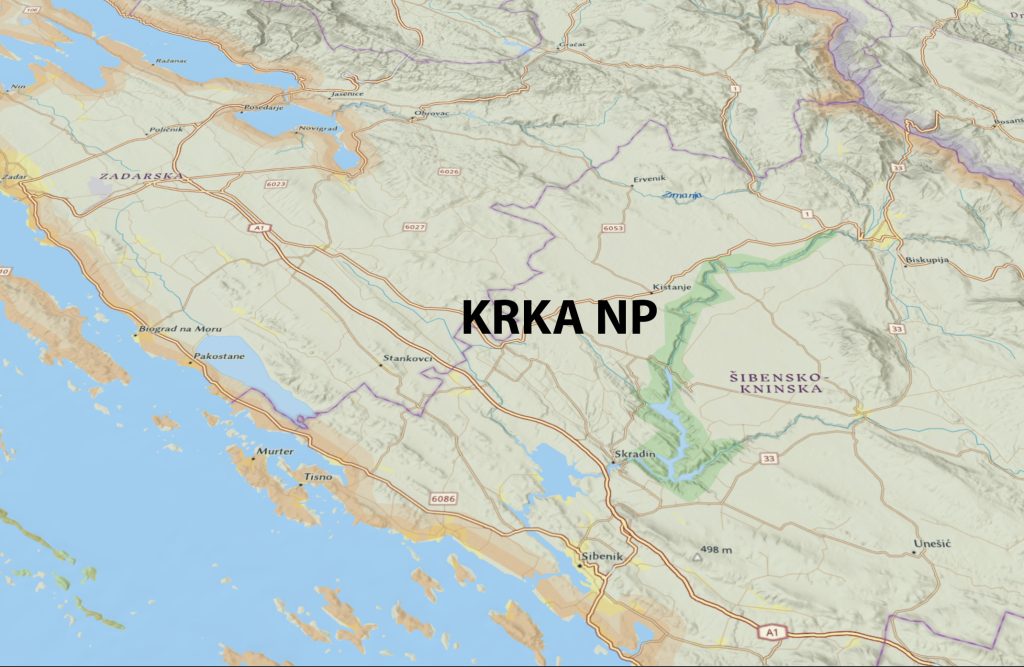
As the river approaches Šibenik and nears the Adriatic Sea, it slows and spreads into calm lakes, framed by lush greenery and broken by travertine barriers that form Krka’s famous waterfalls. Along the way, the river meets the Čikola—a seasonal tributary flowing from Drniš through its own impressive canyon before joining Krka near the majestic Skradinski Buk, the park’s best-known cascade.
Because the park covers such a large area and has multiple access points and sites of interest, the best way to experience its full beauty is by car. With your own transportation, you’ll be able to visit more remote spots like Roški Slap, the island monastery on Visovac, and the Roman ruins of Burnum—places not easily reached by public transport or park shuttle.
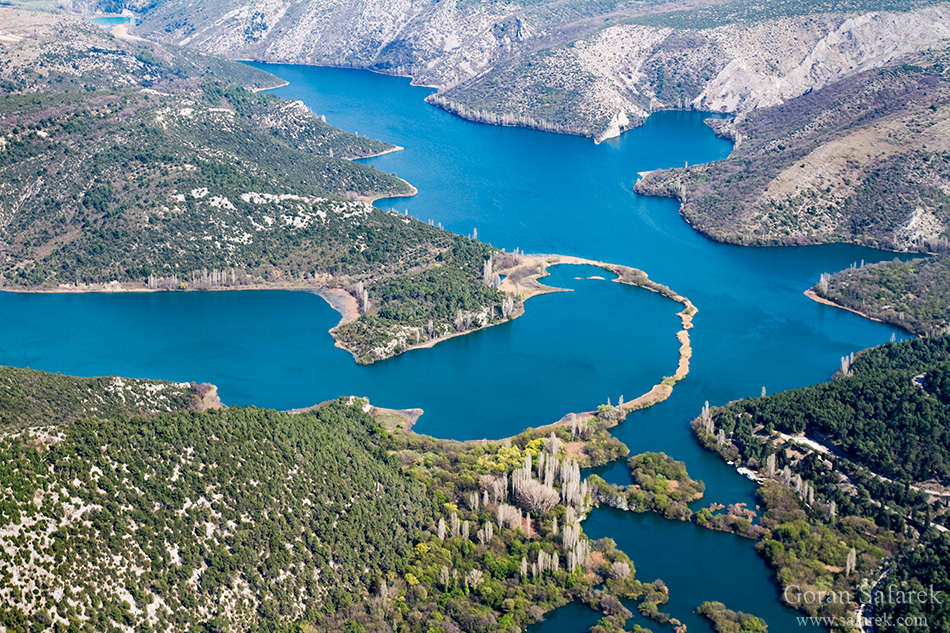
How to Get to Krka National Park
Krka National Park is easy to reach, especially if you’re driving yourself—which is also the best way to explore all the park’s highlights at your own pace.
The park lies just inland from Šibenik, and the Zagreb–Split highway (A1) makes it very accessible. Simply take the Šibenik exit, then follow the well-marked signs toward the park’s main entrances: Lozovac and Skradin.
If you’re traveling via the old magistral road (D1) between Zagreb and Split, you can detour near Knin, where the river begins its journey, and explore the upper sections of the park. This route is especially scenic and passes through traditional Dalmatian villages and rural landscapes.
Krka also has multiple official entrances, so be sure to check which one is closest to the part of the park you want to visit:
- Lozovac – the main entrance, ideal for visiting Skradinski Buk
- Skradin – access by boat during the season, a charming way to arrive
- Roški Slap, Burnum, and Krka Monastery – all best accessed by car
Public buses from Šibenik or Split can get you to Skradin, but connections may be limited, especially outside the summer season. That’s why renting a car is highly recommended if you want to see more than just one area of this large and diverse park.
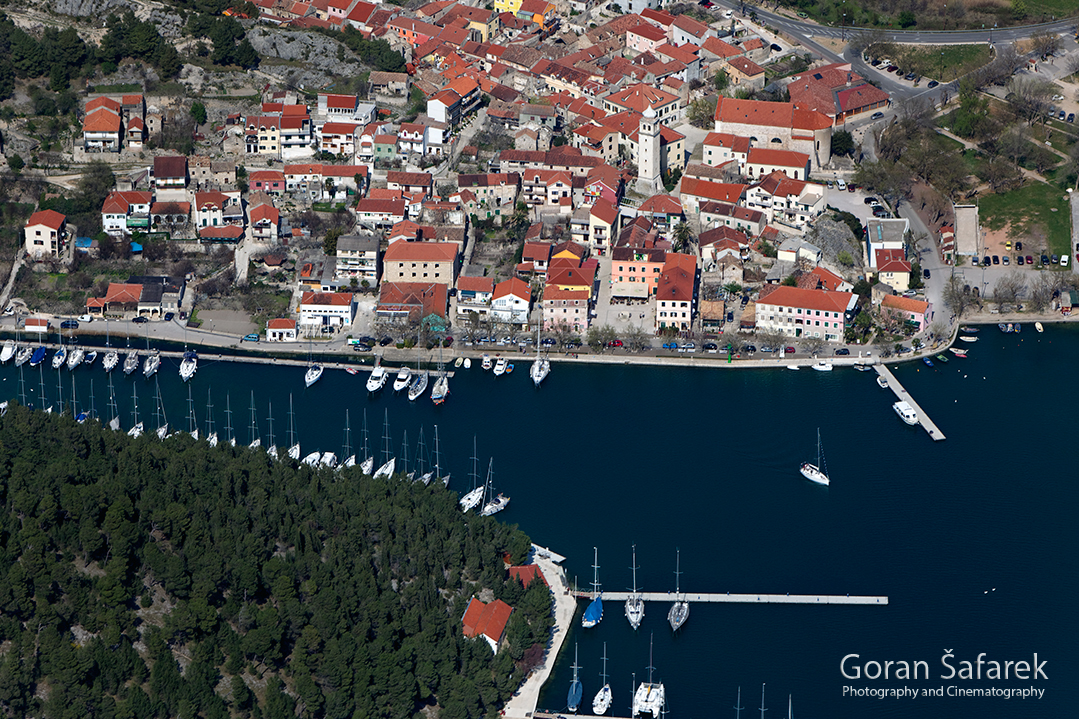
Read our guide to driving in Croatia
When to Visit Krka National Park
Like much of coastal Croatia, summer at Krka National Park means big crowds, high temperatures, and peak prices. While the waterfalls are beautiful year-round, the best time to visit is in late spring (May–June) or early autumn (September–October).
Discover the best time to visit in our Croatia tourist season guide.
In these shoulder seasons, the weather is still warm enough for exploring and boat rides, but the trails are quieter and nature is at its most vibrant. Autumn is especially rewarding, as recent rains swell the waterfalls and the park turns lush and green again after the dry summer months.
If you do visit during July or August, try to arrive as early as possible—ideally right when the park opens. Not only will you avoid the midday heat, but you’ll also enjoy the peaceful beauty of the waterfalls before the crowds arrive.
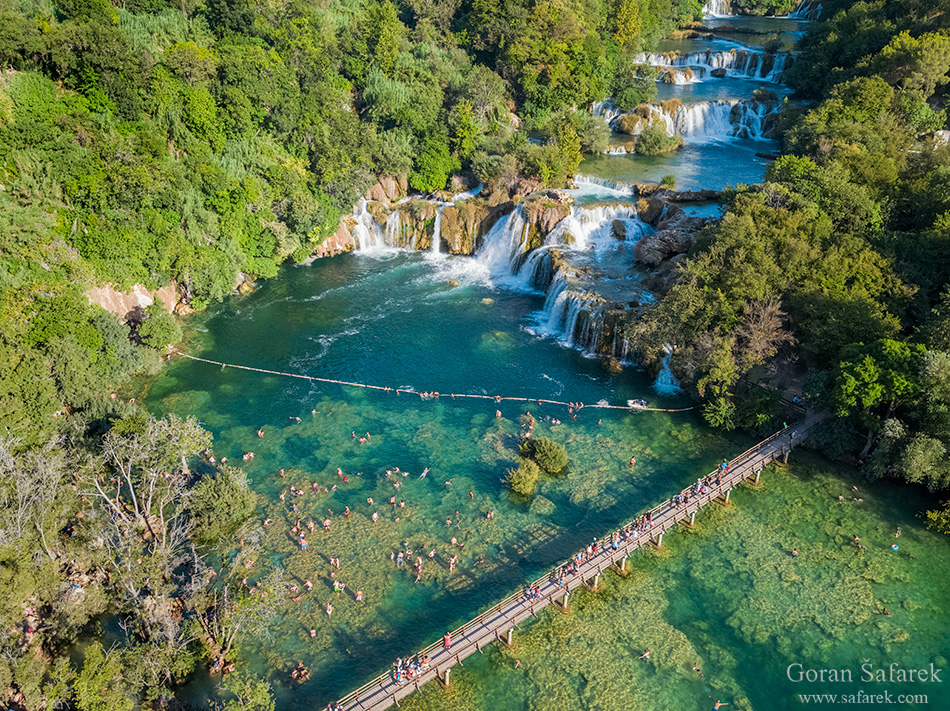
Krka National Park Entrance Fees (2025)
Full Park Access (All Land Sites + Skradinski Buk)
| Season | Adults | Children (7–18) / Students / Croatian Hiking Society Members |
|---|---|---|
| Winter (Jan–Mar, Nov–Dec) | €7 | €4 |
| Shoulder (Apr–May, Oct) | €20 | €12 |
| High Season (Jun–Sep) | €40 | €15 |
- Children under 7: Free entry.
- Late Entry Discount: From June to September, tickets purchased after 3:00 PM receive a 25% discount: adults €30, children/students €11.25.
Partial Access Tickets (Roški Slap, Burnum, Krka Eco Campus, etc.)
| Season | Adults | Children (7–18) / Students / Croatian Hiking Society Members |
|---|---|---|
| Winter (Jan–Mar, Nov–Dec) | €7 | €4 |
| Shoulder (Apr–May, Oct) | €12 | €8 |
| High Season (Jun–Sep) | €20 | €12 |
✅ What’s Included in Your Ticket
- Access to all land sites within the park.
- Boat transfer: Skradin ↔ Skradinski Buk (available April 1–October 31).
- Bus transfer: Lozovac ↔ Skradinski Buk (available April 1–October 31).
- Bus transfer: Laškovica – Roški Slap – Bogatići – Stinice – Roški Slap (available June 1–September 30).
- Educational content: Presentations at Burnum archaeological site, ethno exhibits at Skradinski Buk and Roški Slap, and Oziđana Pećina cave.
- Access to hiking and cycling trails throughout the park.
🎫 Special Discounts & Free Entry
- Persons with disabilities: Free entry upon presentation of a valid ID.
- Children under 7: Free entry.
- Students and Croatian Hiking Society members: Eligible for discounted rates upon showing valid identification.
- Group discounts: Available for groups of 20 or more with prior written notice (at least 24 hours before arrival).
🚤 Optional Boat Excursions (Additional Fee)
Boat tours to sites like Visovac Island, Roški Slap, and the Čikola River canyon are available from April to October. Prices range from €10 to €20 for adults and €7 to €15 for children, depending on the route and duration.
💡 Planning Tips
- Purchase tickets online to avoid queues, especially during peak season.
- Arrive early in the day during high season to enjoy the park with fewer crowds.
- Keep your ticket with you at all times; it’s required for access to transportation within the park.
For the most current information and to purchase tickets, visit the official Krka National Park website:
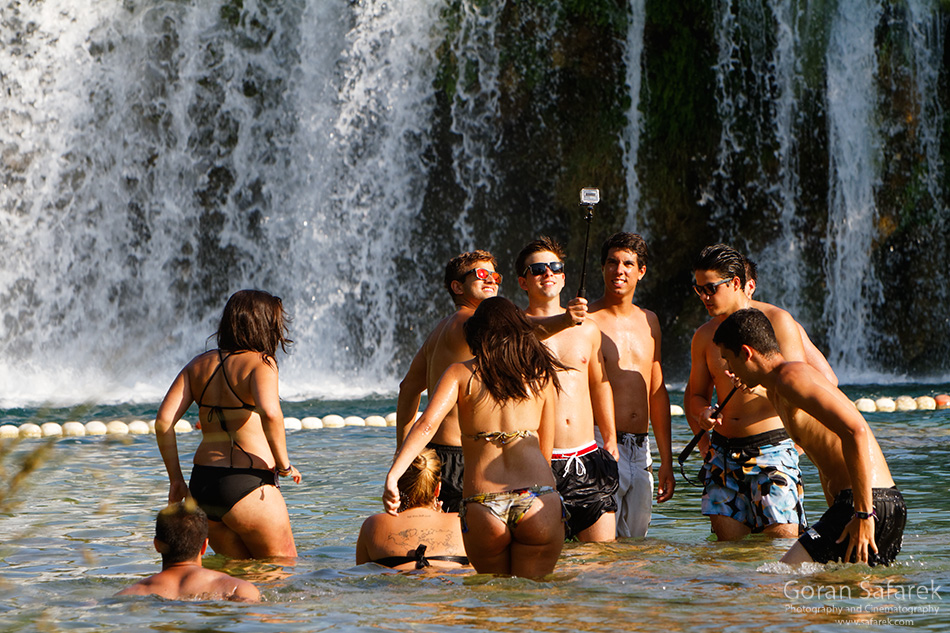
Where to Stay Near Krka National Park
While there’s no accommodation inside Krka National Park, there are plenty of excellent places to stay nearby—especially if you want to spend more than a few hours exploring the park’s many attractions.
Lozovac – Closest to the Main Entrance
Lozovac is a small village perched above Skradinski Buk, home to the main entrance of the park and the bus station for organized transport. You’ll find a good selection of guesthouses, private apartments, and small hotels—many run by local families. This is a convenient base if you’re arriving by car and want to get into the park early in the morning.
Skradin – Charming Riverside Town
Just a short drive (or boat ride) away, Skradin is a picture-perfect town with a marina, cobbled streets, and colorful houses. It’s one of the most popular bases for park visitors, as boat tours into the park start here, and there’s also a hiking trail that leads to Skradinski Buk. Accommodation ranges from boutique hotels and cozy B&Bs to stylish villas and apartments.
Camping Near Krka
If you’re traveling with a camper or tent, camping is a fantastic option surrounded by nature. One of the best choices is Camp Krka, a family-run campsite located just 2.5 km from the park entrance—midway between Lozovac and Skradin. Over 70% of the campsite is shaded by pine forest, and it offers facilities for up to 120 guests, including a bowling alley, sanitary facilities, and picnic areas. It’s peaceful, well-maintained, and ideal for nature lovers and families.
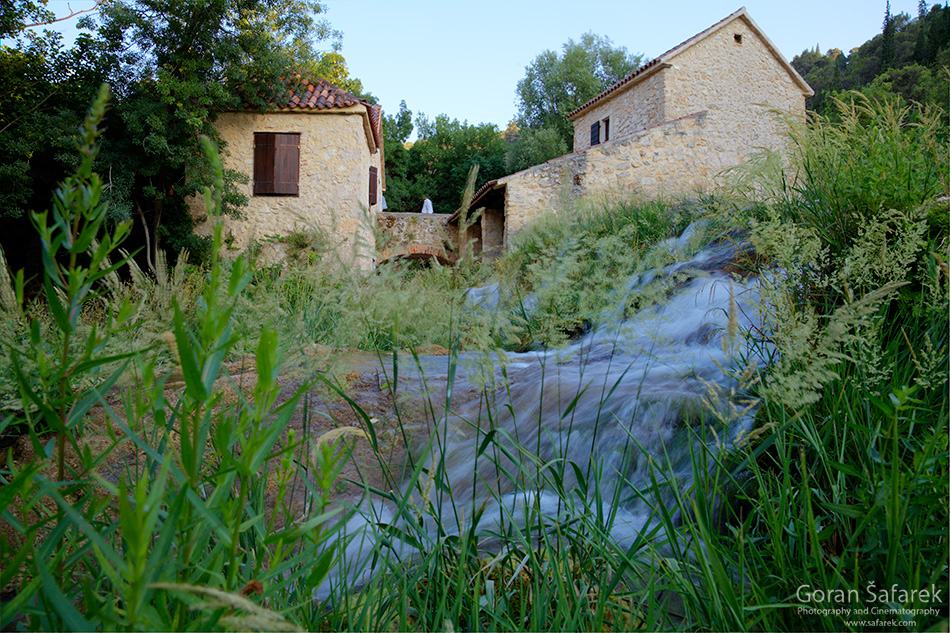
Getting Around Krka National Park
While the Skradinski Buk waterfall—the park’s most iconic attraction—is easily reached by public transport, the rest of the park’s sights are more spread out. The terrain is rugged, and getting around without your own car can be limiting. If you want to explore beyond the main waterfall, driving is highly recommended.
🚤 Boat Tours
Krka National Park operates several official boat lines that let you glide peacefully down the river and witness its beauty and wildlife up close. These run from April to October and are a highlight of any visit.
Included in the Ticket:
- Skradin ↔ Skradinski Buk
A scenic 25-minute ride aboard a quiet electric boat, included in the entrance ticket price.
Optional Boat Excursions:
- Skradinski Buk → Visovac Island (Round trip)
⏱ 2 hours total, includes 30-minute stop on Visovac
💶 Approx. €13 - Skradinski Buk → Visovac + Roški Slap (Round trip)
⏱ 4 hours, includes 30-minute stop on Visovac + 90 minutes at Roški Slap
💶 Approx. €17 - Stinice → Visovac Island (Round trip)
⏱ Short scenic ride across the lake-like river
💶 Approx. €7 - Roški Slap → Krka Monastery + Trošenj Fortress (Round trip)
⏱ 2.5 hours total, includes a 30-minute stop at the monastery
💶 Approx. €13
Note: Boat schedules depend on weather and water levels. Check availability at park entrances or the official website.
🥾 Hiking Trails
Although the park is better known for its waterfalls than for long hikes, some excellent walking trails do exist—just be prepared for exposure to sun, especially in summer.
Stinice – Roški Slap – Oziđana Pećina Educational Trail
This is the park’s flagship hiking route, open year-round and perfect for nature lovers and curious minds.
- 🥾 Length: 8.5 km
- ⛰ Elevation gain: 176 m (from Lake Visovac up to the parking area)
- 🕒 Walking time: 2.5 to 3 hours
- 🪧 Features: Interpretive signs on local wildlife, geology, and cultural heritage
- 🌞 Tip: Bring water, sun protection, and good walking shoes—shade is limited.
🚗 Driving Is the Key
For all other areas of the park, including Roški Slap, Burnum Roman site, Krka Monastery, and lesser-known viewpoints, a car is essential. Public transportation is not available between these points, and boat tours do not cover all areas.
In each section of this guide, we’ll include detailed access and parking tips so you can plan your route smoothly.
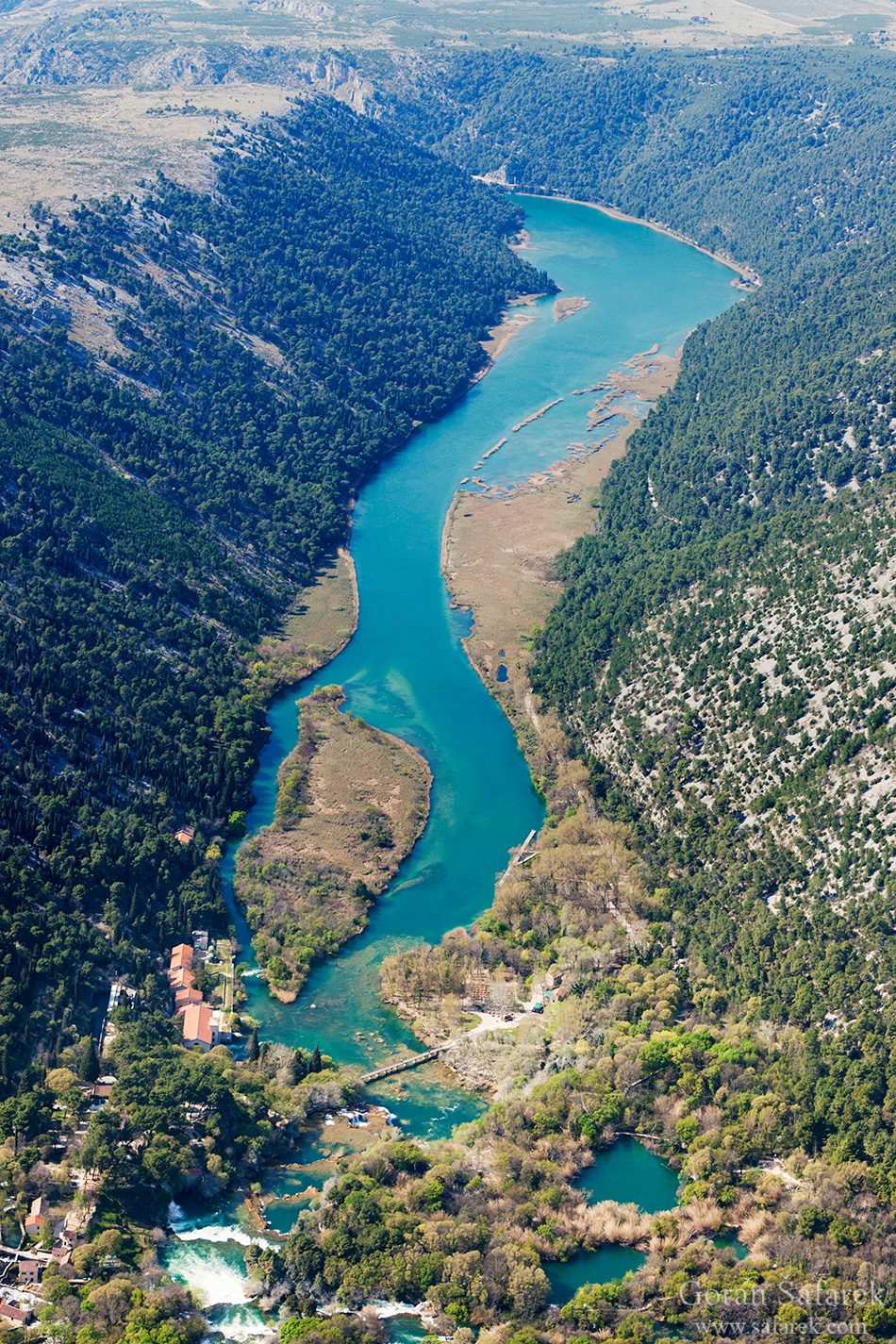
Attractions of Krka National Park
From famous waterfalls to forgotten Roman ruins, Krka National Park offers a rich blend of nature, history, and peaceful retreats. While Skradinski Buk is the star, don’t overlook these other incredible spots scattered across this vast and diverse landscape.

Bilušića Buk
Often skipped by tourists, Bilušića Buk is the first of the seven Krka River waterfalls and a true hidden treasure. To reach it, some hiking is required, but you’ll likely have the entire place to yourself. Two main drops and several smaller cascades stretch 300 meters long, with a 22.4 m height difference. Photographers love it, and adventurers can even climb above the waterfall for a unique view.
How to Get There:
- From Bukovac side: Turn off the Knin–Kistanje road at Radučić (Omčikus), follow an unpaved road to Radučić railway, then hike to the canyon.
- From Promina side: Turn off the Drniš–Oklaj road at Gornji Čitluk, continue to Ljubotić, and then walk 10 minutes to the canyon.
🌈 Manojlovački Slap
The tallest waterfall in the park, Manojlovac tumbles down a series of travertine barriers with a total height of 59.6 m. Its top cascade is a dramatic 32.2 m. When water levels are high, the mist forms vivid rainbows. A viewpoint trail was restored in 2011—don’t miss the plaque commemorating Emperor Franz Joseph I, who visited with Empress Sisi.
Note: The falls often dry up in summer due to nearby hydroelectric diversion.
🏛 Burnum Roman Site
Just a short walk from Manojlovac, Burnum was a Roman military camp from the 1st century AD. Explore the arches of the command building and Croatia’s only Roman military amphitheatre, then continue to the Puljane Eco Campus to view artifacts uncovered here. Open year-round, but only reachable by road.
⛪ Krka Monastery
Hidden in a peaceful river bay 3.5 km east of Kistanje, Krka Monastery is the spiritual heart of the Orthodox faith in Dalmatia. Built in the 15th century atop older foundations, it includes Byzantine architecture, Roman catacombs, and serene river views.
How to Get There:
- By boat from Roški Slap (April–October, 2.5-hour round trip)
- Or by road from Kistanje
🏝️ Visovac Island
Floating like a gem in the Krka River, Visovac Island has been home to a Franciscan monastery and church since 1445. The island holds a museum, an archaeological collection, and a rich library with historic manuscripts. The serene setting makes it one of Croatia’s most photogenic spiritual sites.
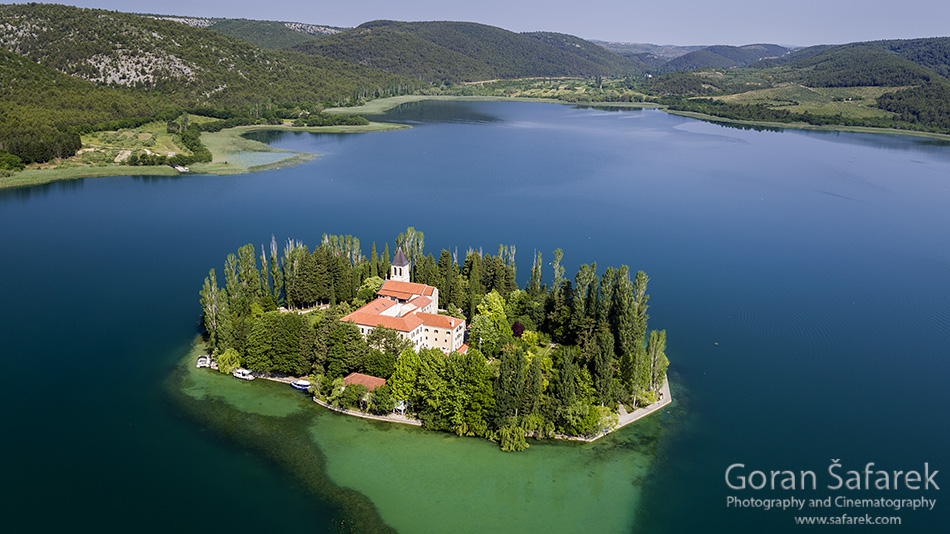
How to Visit:
- Boat tours from Skradinski Buk, Stinica, or Remetić (includes 30-minute visit with monastery, church, and museum)
💧 Roški Slap Waterfall
Known as the “vast waterfall”, Roški Slap includes a 22.5 m drop, swirling cascades called “the necklace,” and small travertine islets. Wooden trails let you explore the area fully, including a climb up 517 steps to Oziđana Pećina cave. On-site water mills now serve as restaurants and museums.
Access:
- By car from both east and west entrances
- By boat from Skradinski Buk (seasonal)
- Small parking available
💦 Skradinski Buk
The park’s most iconic waterfall, Skradinski Buk is a grand finale of cascades, pools, and wooden boardwalks. It’s perfect for walking, photography, and even swimming (only at the base). Ethno museums in restored watermills explain the area’s cultural past.
There are cafes, shaded resting areas, and even a few affordable food stands—but prices can be high, so packing snacks is smart.
Access:
- From Lozovac entrance: free shuttle bus (Apr–Oct) or an 875 m trail
- From Skradin entrance: boat transfer (Apr–Nov), or a 4 km walking/cycling trail
- Optional boat trips to Visovac and Roški Slap available
Other Sites: Medieval Fortresses
Lining the river’s edge are ruins of Early Croatian fortresses: Kamičak, Trošenj, Nečven, Bogočin, and Ključica—the most impressive, perched above the Čikola canyon. These silent stone walls once guarded the region from invaders.
Getting There (Ključica):
- From Šibenik, drive toward Drniš and turn at Goriš village (watch for signs)
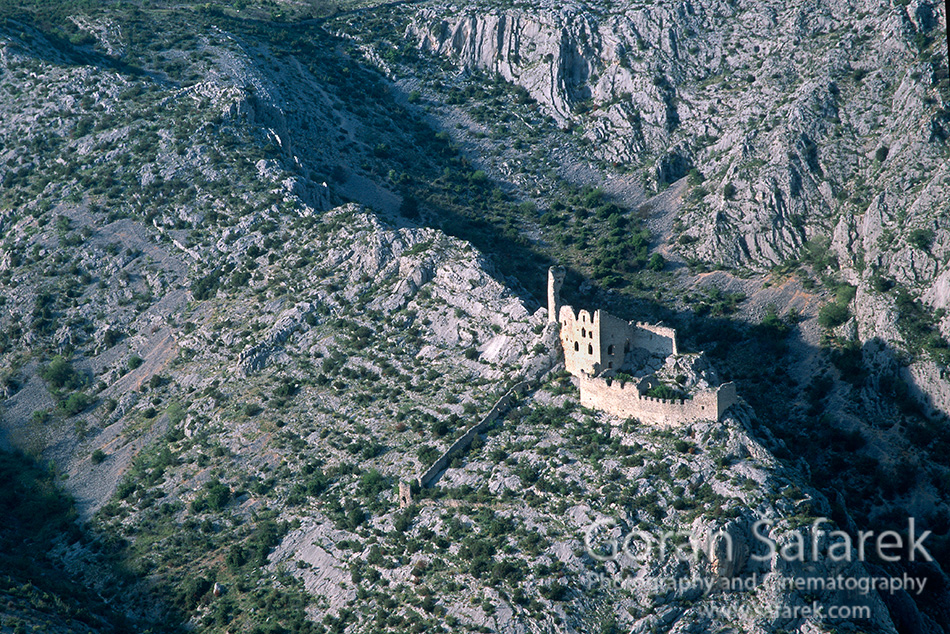
Krčić Waterfall – The River’s Source & Mouth in One
Although outside the national park, Krčić Waterfall (Topoljski Buk) near Knin is a fascinating natural phenomenon. Here, the Krčić River ends in a spectacular waterfall—while the Krka River simultaneously emerges from a cave at the bottom. It’s the rare place where a river’s source and another’s mouth share the same spot.
Access Tips:
- You can also follow the Krčić River back upstream by bike, car, or on foot along a scenic white road dotted with shady meadows—perfect for a picnic or rest stop
- Follow signs from the Knin–Sinj junction
- Parking is available, then it’s just a short walk over the bridge
- Best visited in spring, as the waterfall often dries up in summer
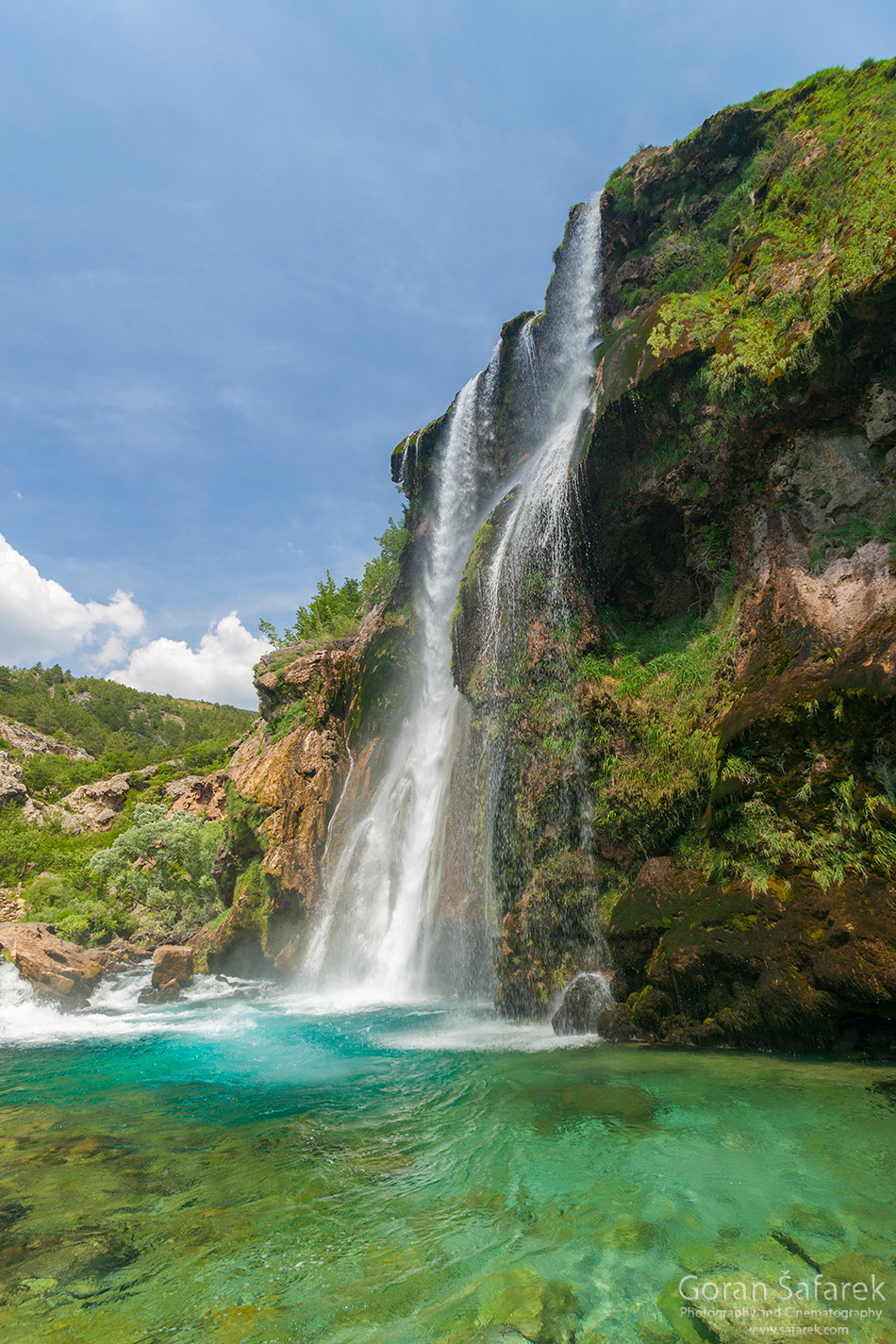
Amenities in Krka National Park
Whether you’re planning a quick visit or a full-day adventure, Krka National Park offers essential amenities to make your stay more comfortable—especially around the main hub of Skradinski Buk.
🍽️ Restaurants & Food Stalls
Skradinski Buk is the most developed area of the park in terms of visitor services. There are several cafés and food booths near the waterfalls and by the boat and bus drop-off points. Expect snacks, ice cream, coffee, juices, and light meals. A few sit-down restaurants are also available near the Lozovac entrance and just outside the park in Skradin town.
Important to note:
- Prices inside the park can be quite high—a simple portion of ćevapi can cost over €10.
- For budget-conscious travelers, it’s wise to bring your own snacks or picnic lunch. There are scenic shaded spots perfect for a riverside break.
🛍️ Souvenir Shops
Near the watermills at Skradinski Buk, you’ll find small souvenir stalls selling local crafts, traditional products, magnets, and books. Some of the watermills also feature ethnographic displays and double as artisan shops.
🚻 Toilets
Public toilets are available and free at major entrances (Lozovac and Skradin) and near Skradinski Buk. Facilities are well-maintained during the high season, but expect lines during peak hours.
🪑 Picnic & Rest Areas
There are plenty of benches and picnic tables in the shaded areas surrounding Skradinski Buk. These are great spots to rest, enjoy a packed lunch, or cool off after walking the trails.
What You Shouldn’t Do in Krka National Park (And What Is Allowed)
Krka National Park is a protected natural area—and to keep it as stunning and serene as it is, there are some clear rules you should know before visiting.
❌ What’s Not Allowed:
- 🚁 Flying drones –
While they’re a common sight elsewhere, drones are strictly prohibited in the park without a special permit. Fines can be steep, and rangers do enforce this. Leave the buzzing to the bees. - 🏕️ Camping –
Camping is not allowed anywhere within the boundaries of Krka National Park. If you want to sleep near nature, stay at a designated campsite like Camp Krka, located just outside the park. - 🔥 Open fires and barbecues –
No open flames are allowed, including grills and stoves. This rule is especially important during dry summer months when wildfire risk is high. - 🚯 Littering or damaging nature –
Take only photos, leave only footprints. Removing plants, rocks, or disturbing wildlife is prohibited. - 🎧 Loud music and disturbing behavior –
The park is a haven of peace and natural beauty. Respect other visitors and the wildlife by keeping noise to a minimum. - 🐕 Off-leash pets –
Dogs are welcome but must be on a leash at all times. Clean up after your pet. - 🚫 Swimming outside designated areas –
You can only swim at Skradinski Buk, and even there, only in designated zones. Swimming is not permitted at Roški Slap, Visovac, or elsewhere in the river.
✅ What You Can Do:
- 🎟️ Use your ticket freely –
Your park ticket includes entrance to all land sites, free boat or bus transport from the Lozovac and Skradin entrances, and access to museums, mills, and trails. - 🧺 Enjoy a picnic –
Feel free to bring snacks or a lunch. There are designated rest areas and shaded spots, especially near Skradinski Buk. - 📸 Take photos –
Photography is welcome—just be mindful of your surroundings and respectful of others. No drone footage, but plenty of ground-level beauty. - 🥾 Hike and explore –
Krka has several well-marked walking trails, including the Stinice–Roški slap–Oziđana pećina educational trail. Just be sure to stay on marked paths. - 🚲 Cycle in permitted zones –
Certain trails, like the Skradin–Skradinski Buk route, allow cycling. Follow signage and respect pedestrians. - 🛥️ Take boat excursions –
Official park boats run seasonally and are a fantastic way to see the park’s beauty from the water.
Respect the rules and you’ll not only avoid fines, but also help preserve Krka’s magical landscape for generations to come. 🌿
